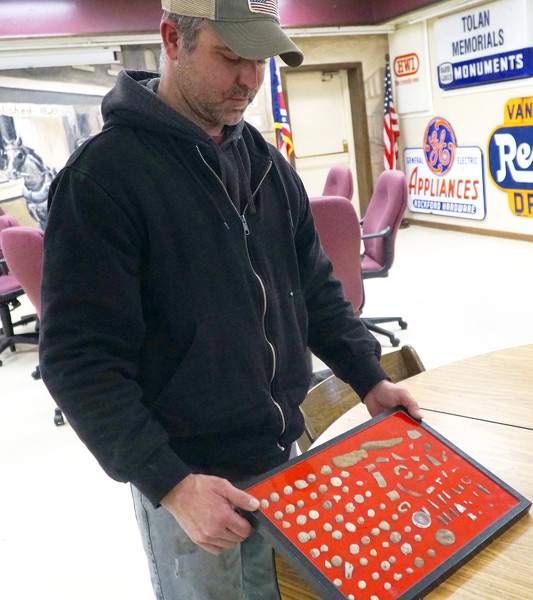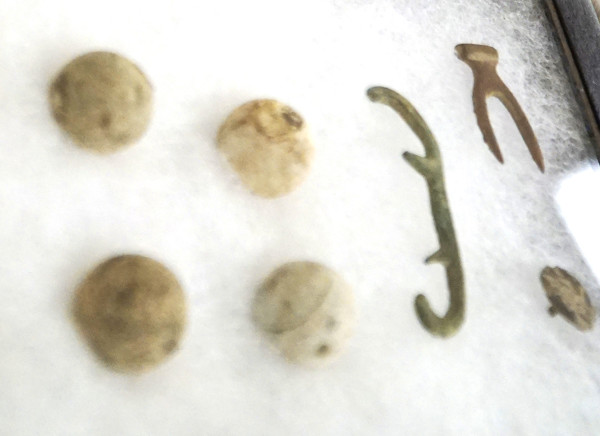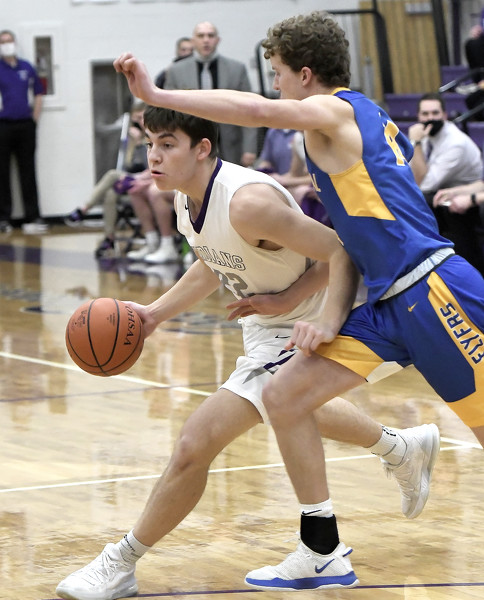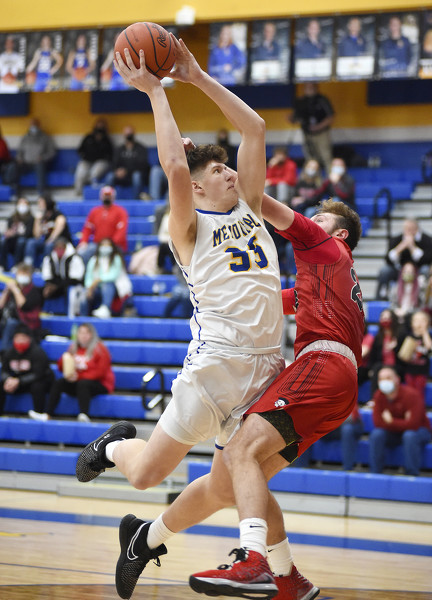Saturday, January 16th, 2021
Buried treasures
Man's metal detecting uncovers local history
By Sydney Albert

Photo by Sydney Albert/The Daily Standard
History enthusiast Eric Kuhn, Rockford, stands with some of the artifacts he has unearthed from the area. Lead musket balls, shown on the left half of the case, are some of the most common artifacts he finds locally.
ROCKFORD - Many might be surprised at the amount of history hidden around them, whether it's tucked away in an attic, behind a wall in their home or beneath the ground.
One local man, Eric Kuhn, has taken to hunting down the artifacts of history buried beneath our feet, and said he wants to begin giving back his discoveries to bolster understanding of local history.
Equipped with a metal detector and his knowledge of Mercer and Auglaize's past, Kuhn, 40, has been scouring local fields, riverbanks and historical sites for years. After getting out of the military in 2003, he and his father, a fellow history enthusiast, discussed getting metal detectors to see what relics could be found in their own backyards.
Almost two decades later, Kuhn now has an entire room in his house dedicated to storing his finds, and he's helping to track down parts of the past that might otherwise have faded from memory.
Kuhn has searched the grounds of old homesteads and one-room school buildings in the area and was even allowed to search the site of the old Fort Adams located near Rockford, once built by General Anthony Wayne. Along with musket rounds and colonial uniform clasps and belt buckles, he found two original 1792-1796 pewter legion military buttons.
Over the past year, however, Kuhn wanted to try locating something more challenging: the sites of old Native American settlements.
The location of old native settlements aren't well documented on maps. Areas such as Rockford may have a little more documentation that has been passed down over the years, word that a village had been in a certain area or near someone's house, he said.
When he's doing reconnaissance and looking for possible sites, Kuhn looks for a few specific things.
"The key to finding these spots is, natives were no different than us: they camped on high ground. Ninety-nine percent of the time they camped on high ground, and if they couldn't find any high ground, they were close to a waterway," he said.
He looks for sandy soils, as well. Native Americans from this area favored sandy topsoils because when it rained hard, the ground drained better and didn't become a muddy, sloppy pit, Kuhn said.
A standard metal detector is only good for detecting 6-8 inches below the surface, Kuhn explained. His equipment is a bit more advanced than what some casual hobbyists might have. This allows him to look for items as far as 10 feet below the soil surface and locate cave voids, buried guns and cast iron kettle pots.
Kuhn said he's found Native American trash pits this way, filled with bone fragments, antlers and other items. Some of the items in the pits can date back to the 1700s, while others can date back to centuries earlier.
Other finds include silver used for trading, weapon parts, shell buttons and "kettlepoint" arrowheads. The arrowheads most people think of tend to be those from prehistory, Kuhn said. Kettlepoint arrowheads were created from kettles the natives got from settlers and traders by breaking the metal into smaller parts and rolling them into points.
In his searches, he's also found a number of old coins. The oldest is a Mexican Half Real coin dated from 1732 he located on a high bank of the Wabash River.
"I'm pretty good at finding this stuff. It's just getting the permission," Kuhn said.
Sometimes, property owners or farmers don't want him in their fields, which Kuhn understands. For the most part, though, people in the area are pretty friendly, he said. Sometimes, the property owners tell him he can keep whatever he finds, as long as they send him a picture of anything interesting he unearths. Other times, the owners have said that anything he finds belongs to them.
Kuhn doesn't mind either way.
"It's more about finding the history than anything."
He's already amassed quite a collection over the years. Now as he begins to dive into the Native American history of the area, he's actually looking to give away his finds to others.
"I want to be able to find this stuff and give it back, because I've found so much stuff over the years to where I feel like it's the right thing to do," Kuhn said. "I want kids to be able to touch it and see it, examine it, tell the story behind it."
As he begins to tackle the Rockford area, he aims to give his findings over to the Shanes Crossing Historical Society or the Rockford Historical Museum.
Mike Schumm and Norm VanTilburg, members of the Shanes Crossing Historical Society, spoke with Kuhn on Friday about how much history was unknowingly lost when people got rid of old documents from deceased loved ones or tore down old structures. They've often asked if they could take a look inside old houses in the area if people planned to tear them down, hoping to save any artifacts they could find.
Kuhn seems happy to help find and preserve what local history he can.
"If you don't do anything, it just sits in the ground. It deteriorates," he said.

Photo by Sydney Albert/The Daily Standard
Lead .68-caliber Charleville musket rounds share a case with colonial uniform clasps and belt buckles. Eric Kuhn found these in the area of Fort Adams, once located near Rockford and built by General Anthony Wayne.



